There are 19 types of hawks in North America alone from the more than 200 hawk species in the world.
Hawks are swift and mighty raptors that deserve more attention than they enjoy, especially since some of the scant attention they get has them confused with falcons.
Hawks used to be treated as a pest because of their predatory nature. This disdain has led to these birds being previously hunted and neglected.
We hope this article will set the stage for the homecoming of these beautiful raptors by presenting some introductory info to drive your interest.
Because you know, our motto is “when you are interested, you care. And when you care, you do something about it.” Let’s preserve our wildlife together!
In today’s article, you’ll learn about the many hawk types, such as these fantastic beasts’ habitats, diets, and where to find them.

What Is A Hawk?
Generally, the hawk is any of the birds of prey in the Accipitriformes order that vary from small to medium-sized.
With keen eyesight, hawks are able to see eight times clearer than humans and in color.
Most hawks are robust raptors that have a range of 18 to 30 inches in size and often prefer living in large, open spaces of North and Central America, the West Indies, and Jamaica. But they can be found in most continents except Antarctica.
Different types of hawks keep a diet consisting of small mammals, reptiles, and some seafood caught frolicking in shallow waters like crabs.
Most types of hawks dive from the sky or perch to catch their fleshy targets with sharp, curved talons and tear into the prey with hooked beaks.
These different types of hawks come in various colors, with white, dark brown, and black generally in the mix.
Stripes also play an essential part in the plumage of most hawks. The hawk umbrella term is mainly divided into two groups: buteos and accipiters.
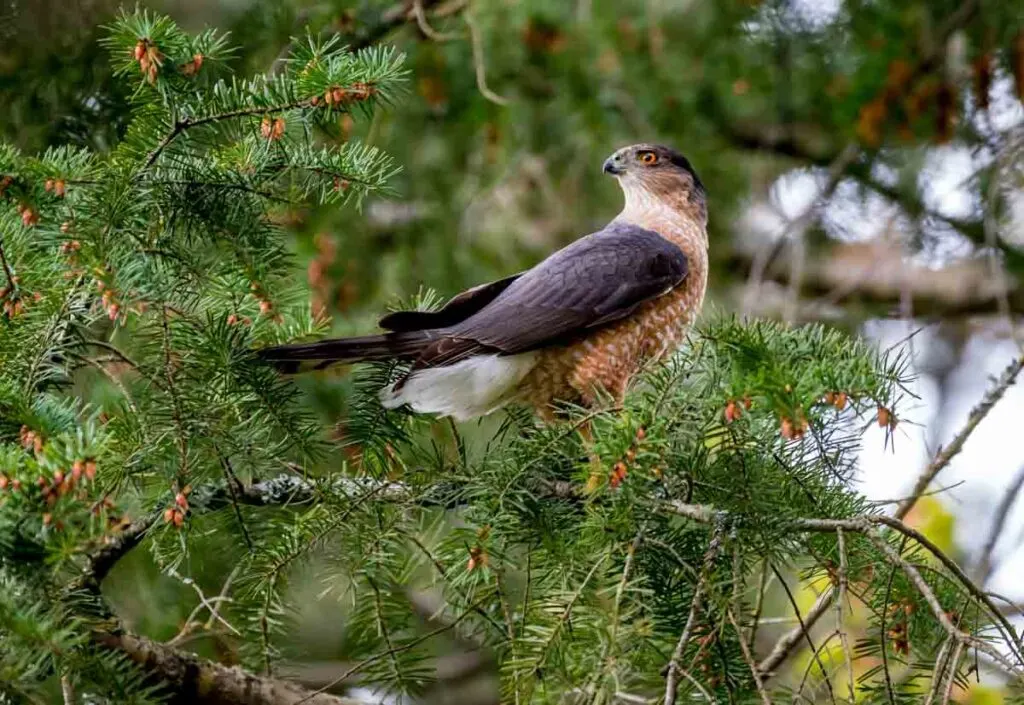
The Two Hawk Types/Groups
There are two groups of hawks: Accipiter and Buteo.
The accipitrine hawks generally hunt birds as their primary prey. They are also called hen-hawks or wood-hawks because of their woodland habitat.
The buteo family of hawks is called buzzards or hawk-buzzards in some parts of the world, and this group is characterized by its shorter tail, broader wings, and more muscular build.
Buteos fly further in open spaces than accipiter hawk types and use their larger stature to descend or pounce on their prey stealthily.
Buteos make fewer meals out of birds than accipiters and prefer small mammals with a more negligible risk of aerial outmaneuvering.
Unfortunately, this consideration for birds is not out of kindness; the buteos hawk types probably need to hit the treadmill more as it is less agile than the accipiter family.
21 Types of Hawks
Here are 21 different types of hawks that you can spot in the wild. How many of these have you seen in real life? Let us know in the comments! We’d love to hear from you!
1. Red-Tailed Hawk
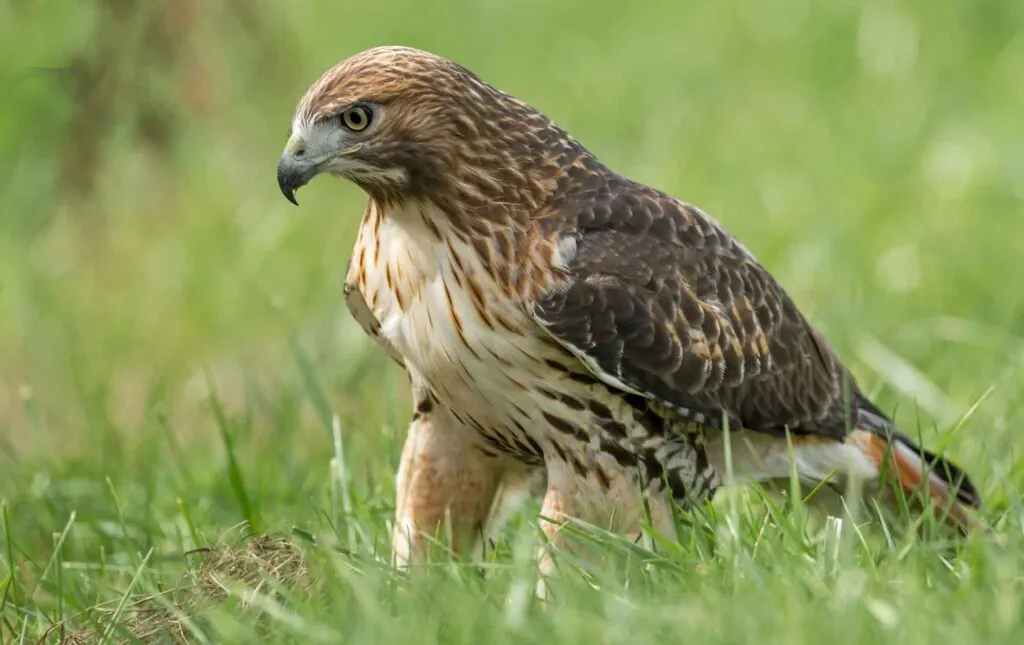
Red-tailed hawks have incredible eyesight, spotting their prey 100 feet from the air. Their dive speed may exceed 120 mph, making them one of the fastest birds in the world.
These types of hawks hunt rodents, lizards, rabbits, and even larger birds or other similar game moving across the ground perched on a tree branch or circling the area from above.
You might see this 1.52-to-3.91-pound Buteo jamaicensis snatching up some unsuspecting mouse on the side of the freeway.
Once its prey is caught with the bird’s strong talons, red-tailed hawks will usually fly back up to their perch to feast on its catch of the day.
Also, these buteonine hawks are the most common hawks in North America. You can see them from inner Alaska and northern Canada to Panama and the West Indies. In their distribution, red-tailed hawks aren’t a picky bunch.
Red-tailed hawks aren’t afraid to appear as roadside attractions as they might live on roadsides to open country, mountains, plains, woodlands, and similar habitats.
With bodies sized 18 to 26 inches and an impressive 38 to 43-inch wingspan, red-tailed hawks are some of the more prominently sized Buteo hawks in North America.
2. Sharp-Shinned Hawk
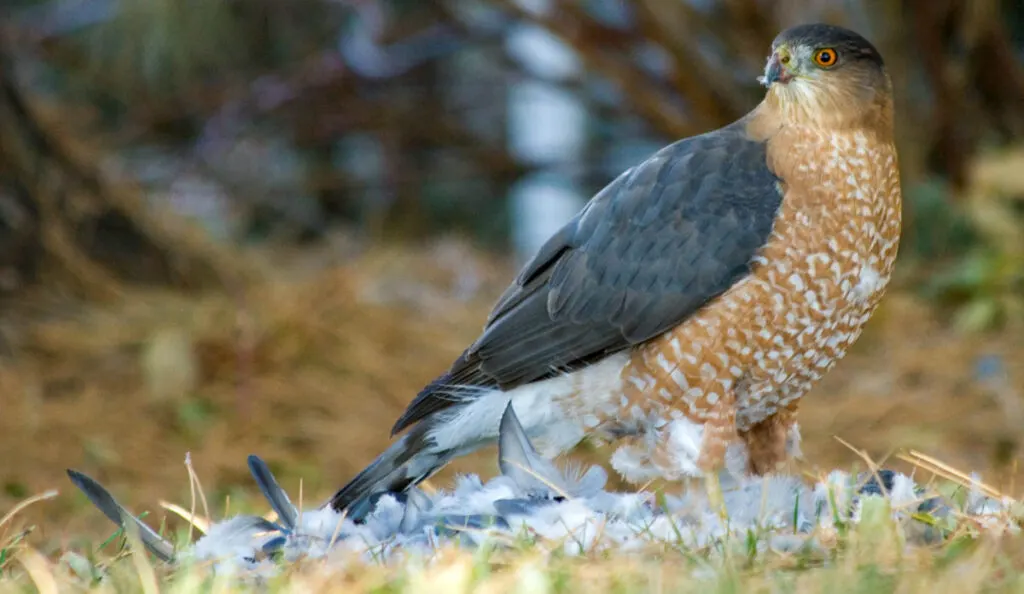
Accipiter striatus is one-third the size of Cooper’s hawks but looks very similar in appearance.
When fully grown, these birds spot a dark, blue-gray back and a brown-barred chest. Instead of having a rounded tail, the sharp-shinned hawk‘s tail is squared. Their young ones are mostly brown with broad dark bands across their tails.
Sharp-shinned hawks inhabit the forested areas of North to Central America, spreading out to Brazil and Argentina.
Don’t pin these jet-setters to one place, as they are a highly migratory hawk species. These types of hawks will pack up and fly southward out of the northern US in September in search of greener pastures.
Sharp-shinned hawks winter in the warmer regions of Central America.
These 0.181-0.485-pound birds are sometimes seen fraternizing with Minnesotan bird feeders in winter.
Like other birds of prey, female sharp-shinned hawks are almost twice the size of the 0.181-0.265-pound males.
Female hawks can weigh 0.331-0.485 pounds. It’s suspected that females in birds of prey need the added oomph for incubating their eggs because they don’t hunt as regularly as the males, who must be agile to catch other smaller birds.
In their woodland quarters, these regal birds primarily feed on small songbirds.
3. Cooper’s Hawk
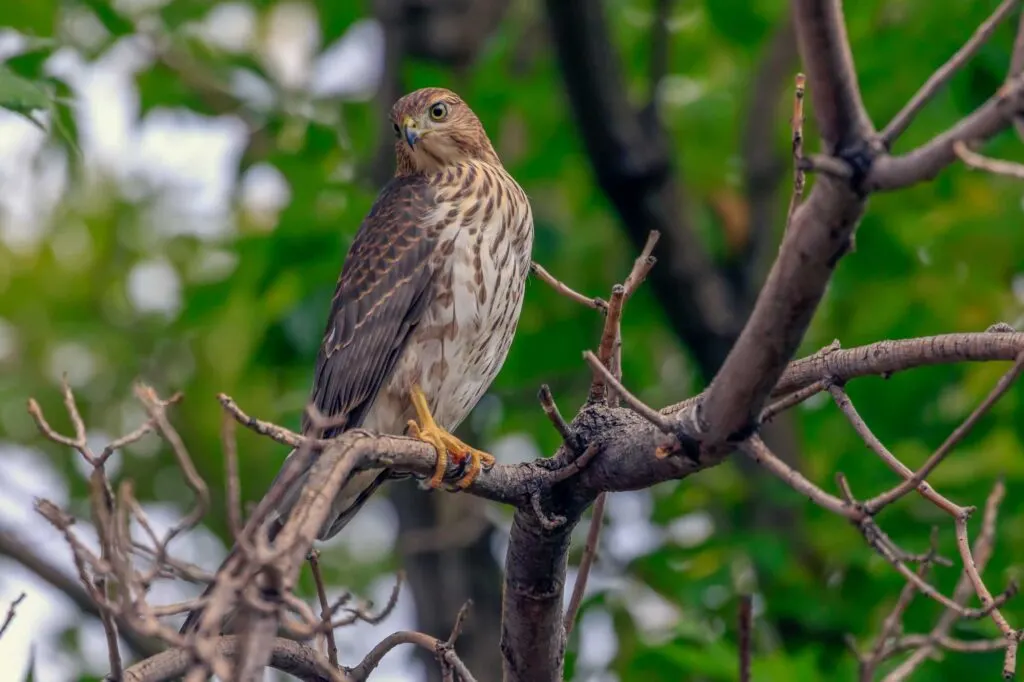
The population of Cooper’s Hawk is currently showing an upward trend. The Accipiter cooperii are of least concern in the IUCN Red List of Threatened Species.
So, we can rest assured that colonial America’s “chicken hawk” will be around a bit longer than the only native parrot species in North America, the Carolina parakeet.
Identifiable by its long black-banned tail with a rounded tip, you’ll hear Cooper’s Hawk low-sounding keh-keh-keh before seeing this sneaky, 1.169-pound bird.
This medium-sized hawk cackles out around its nest in mixed and deciduous forests, open woodlands, and forested highland regions. When migrating, they might also stay in deserts.
Cooper’s hawk is common throughout the suburban areas of the US and southern Canada.
The suburban romancing of these types of hawks is thought to be thanks to the East’s reforestation. This bird enjoys medium-sized birds as a staple part of its diet to satisfy its great figure.
4. Northern Goshawk
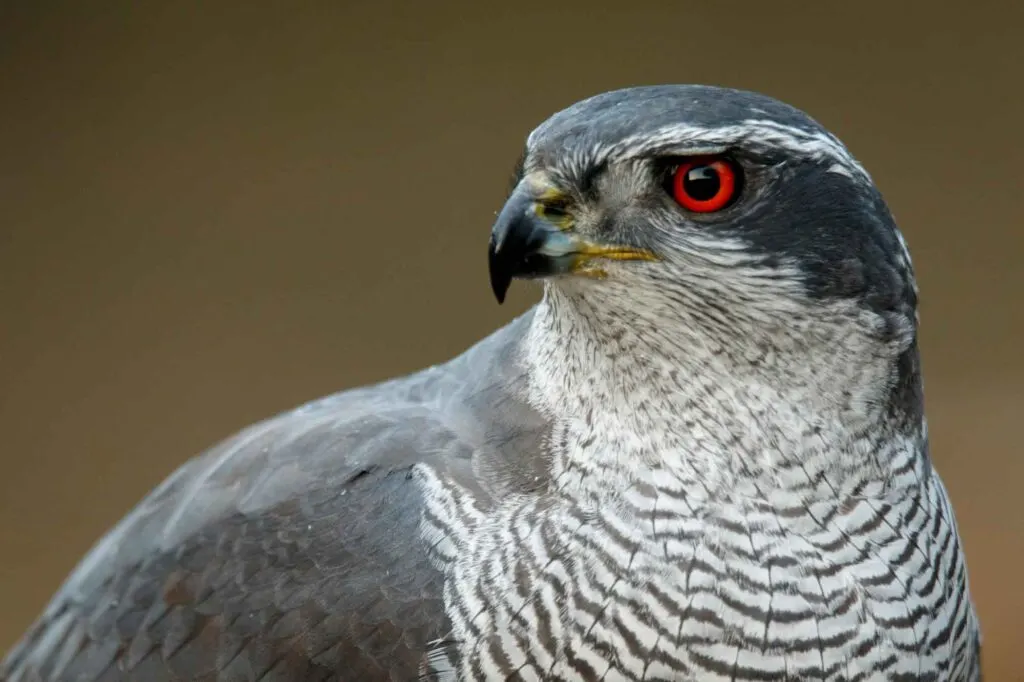
Northern goshawks have a standard distribution in large parts of Europe and Northern Asia.
They are also found across North America, which includes central and western Alaska, the United States, and Rocky Mountain altitudes central to southern Mexico.
Accipiter gentilis are sometimes considered “true hawks” for being in the Accipiter subfamily. This 1.389-3.087-pound bird sets up its habitat in coniferous forests and dense forests.
To help sustain their considerable girth, these opportunistic hunters enjoy an assortment of medium-sized mammals and birds, like squirrels and crows.
Charmingly, the mostly gray northern goshawks have white stripes over their sunny-colored eyes that make them appear ready to give aged and whiskey-sweet advice.
Did you know? Of all the collective nouns for animals, the collective nouns for birds are the most curious ones. A group of goshawks is called a flight of goshawks!
5. Red-Shouldered Hawk
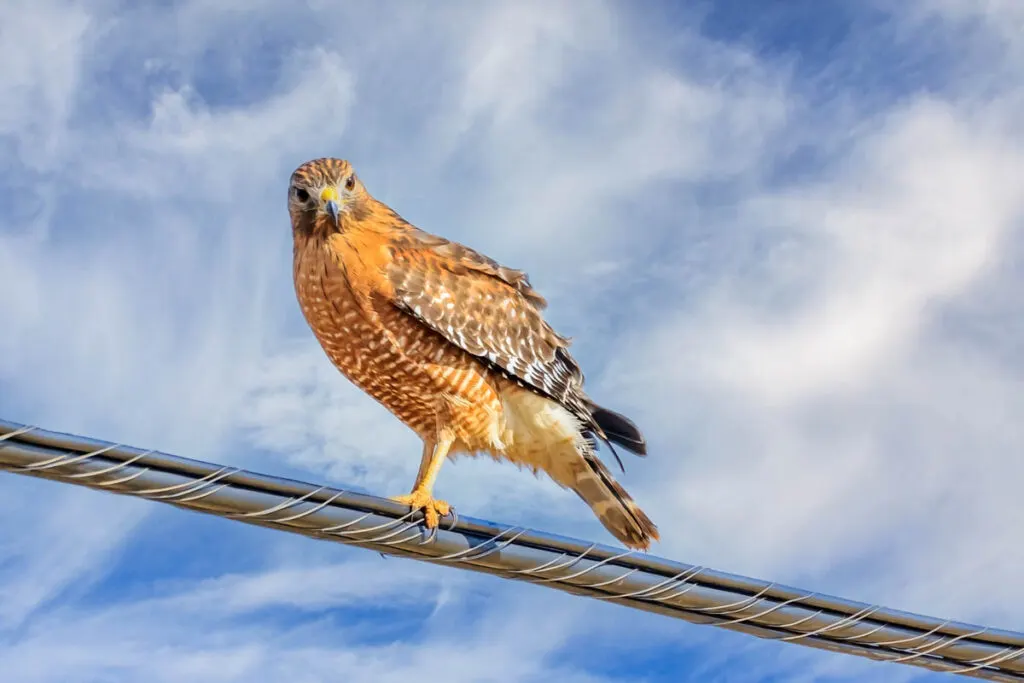
The red-shouldered hawk ranges from 1.21 to 1.54 pounds with upper wing feathers that have a red dye to their color, which makes the birds seem like they have red shoulders.
Buteo lineatus live in the forested and swampy regions of eastern and northeastern US to southern Canada.
You might also see them in California, west of the Sierra Nevada.
Birders might notice the eerie scene of the dead trees around the red-shouldered hawk’s high perch in hardwood trees.
That’s all to the bird’s liking, as they like to have these leafless trees to perch on and scan the forest floor.
On seeing different small mammals, they’ll drop down on top of their prey like a guided missile.
No squirrel, rabbit, snake, lizard, or amphibian is safe when the red-shouldered hawk is around.
Like a true warrior’s proclamation of their claim to territory, these typically solitary birds will call out a “kee-aah.”
They also use this call to show their alarm. These are physical birds, as they use their body and voice to communicate their interest by dancing a duet by flying and circling each other in the sky.
You may have seen red-shouldered males performing their courtship “sky-dance,” which involves soaring high into the sky and coming back down through steep dives.
These types of hawks are homebodies as they’ll generally stay in the same region throughout the year and won’t migrate.
6. Broad-Winged Hawk
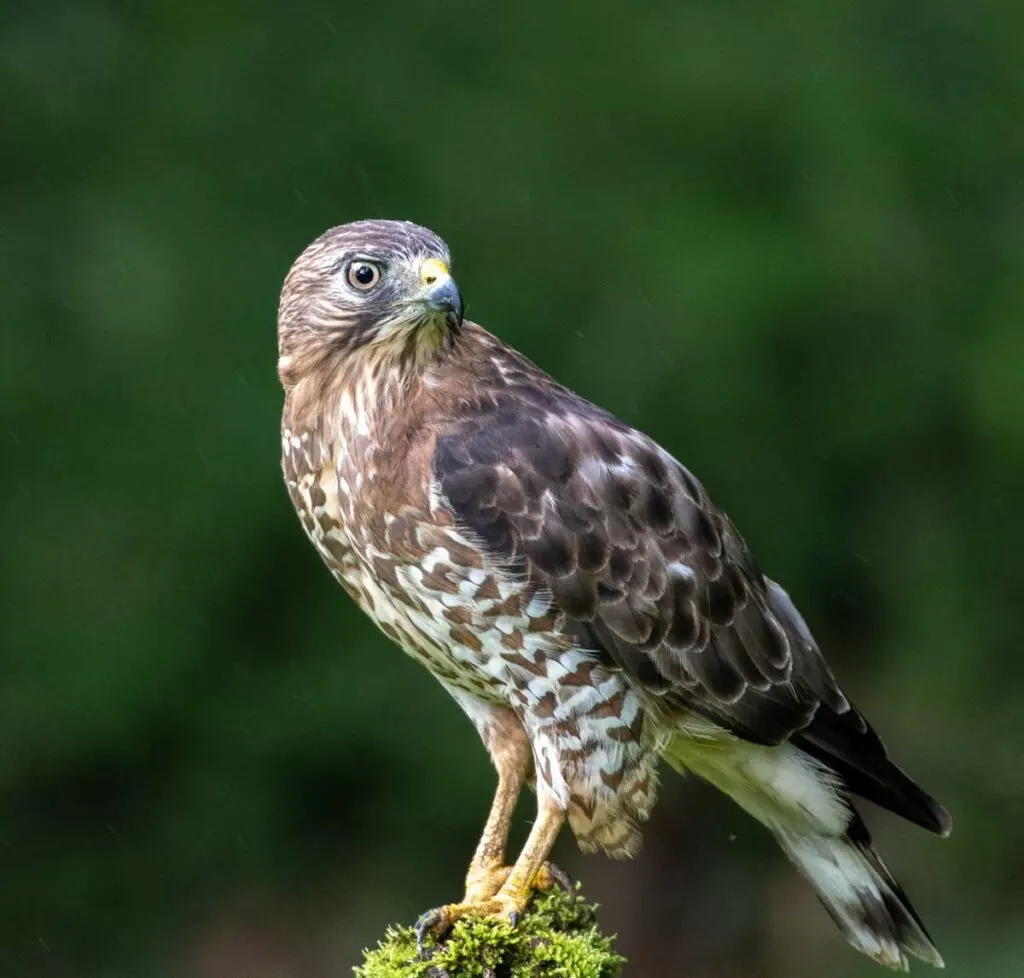
Buteo platypterus are smaller and more compact hawks with large-sized heads.
The rusty bars on their chest make them look like they applied strips of sunscreen without didn’t spread them.
The broad-winged hawk’s “kih-keee” whistle is so high in pitch that many wouldn’t consider it the call of a mighty raptor.
Broad-winged hawks weigh usually around 9.3-19.8 oz. This hawk also likes to look down on its subjects and food by perching or soaring from a high vantage point.
The hawk will descend on its desired small mammal, nestling bird, or sizeable insect directly from above or side.
To have a clear view of the ground, these birds like to perch on telephone poles, fence posts, and tree branches.
These birds are widely distributed in North and South America and breed in the eastern and northern regions of North America, with some groups, called kettles, migrating down to winter in Florida, southern Mexico, and into northern South America.
Did you know? Ospreys are often mistaken for hawks and are sometimes called Sea Hawk, River Hawk, and Fish Hawk.
7. Ferruginous Hawk
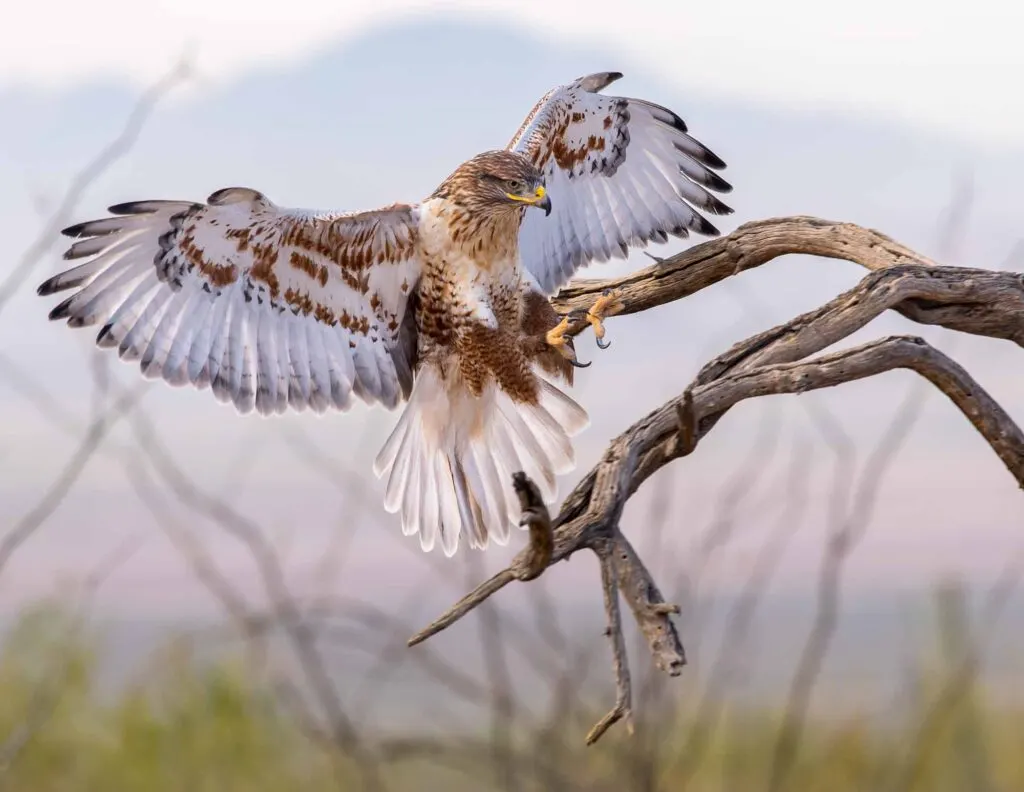
Ferruginous hawks (Buteo regalis) are endemic to North America and are the largest-sized hawk there. These 3.31-pound birds are the largest North American hawks.
The light morph hawk is the most common one, so you can make out a ferruginous hawk from its pale head, rusty-colored shoulders and back, and rusty-washed white tail.
But if you spot a dark morph, know it leans toward a chocolate brown, which also has signs of the rusty colored marks that give the ferruginous hawk its name.
This bird of prey gets its name from the rusty hue that colors most of its features, with ferruginous meaning reddish brown or rust-colored.
Their habitat includes mixed-grass prairie, shrub grasslands, deserts, open country, and grassland. These birds appear not to nest in areas transformed into agricultural lands.
You might see them between southwestern Canada, the western US, and northern Mexico. Ferruginous hawks will eat any abundant small prey, like some white-tailed jackrabbits in southeastern Montana.
8. Harris’s Hawk
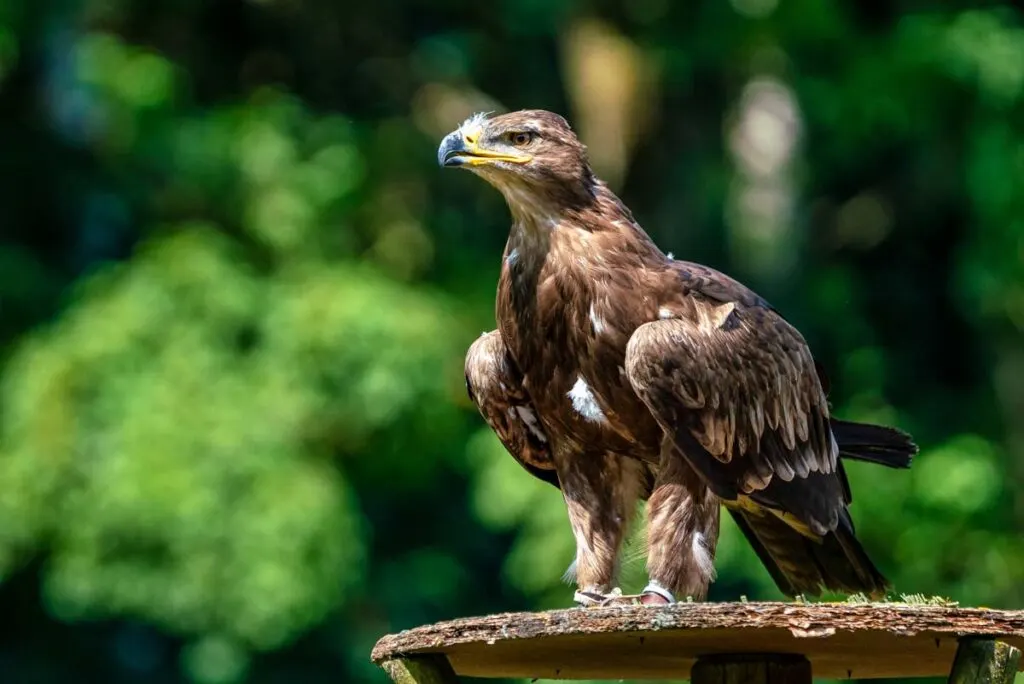
With their broad wings and long, probably sassy, nails, these 1.62-2.32-pound birds aren’t to be taken lightly.
Just ask any of the small mammals that Harris’s hawk feeds on. Parabuteo unicinctus are opportunistic feeders able to hunt and stomach a wide selection of prey and live on whatever has abundant numbers.
As you can imagine, it’s difficult for rodents or lizards to hide from this foraging raptor as it circles above its semi-open habits and upland deserts.
Like its diet, Harris’s hawk can survive different habits, from the mountainous deserts growing mainly saguaro cacti and mesquite trees to palo verde and ironwood woodlands in the valley of the Colorado River.
These hawks are non-migratory and usually stay year-round in their southwestern US and northwestern Mexican estates.
You might also find these birds in urban areas hanging around open lots, washes, and open deserts.
In a winsome turn of events, parents will share parental care duties. This bird’s real deal is that it is a highly social raptor that flocks together in preferred larger casts to better guarantee its survival.
With strong conservative-Hollywood backing, these social birds pushed the idea of birds that hunt together and stay together.
Well, that may or may not have been created on the spot—but why would you want to disprove such a sweet lie?
9. Swainson’s Hawk
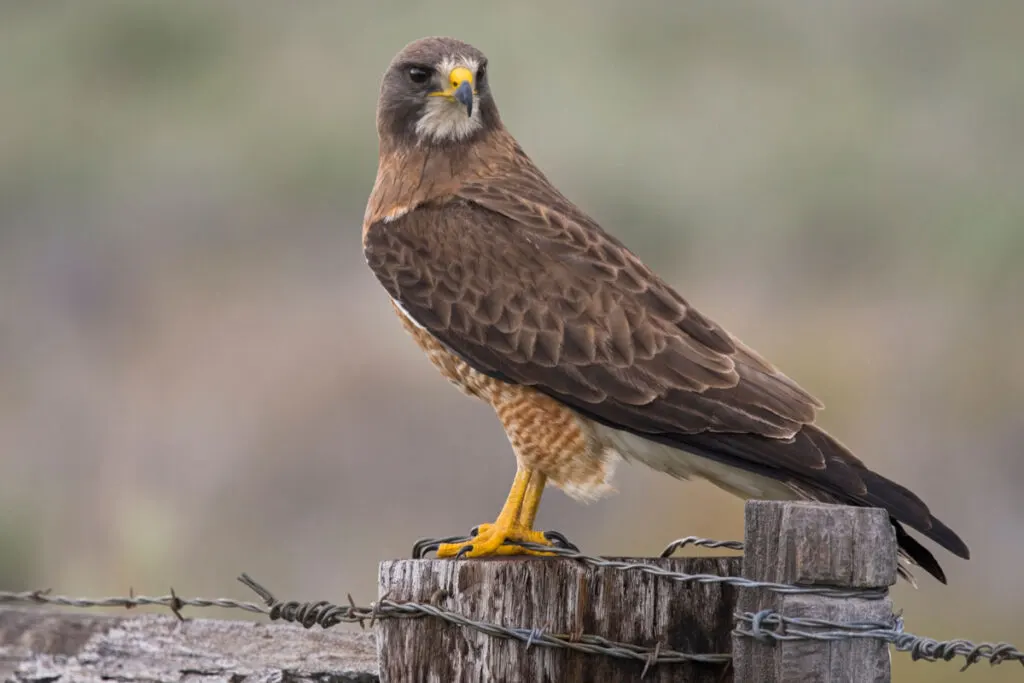
The thin-bodied and narrow-winged Swainson’s hawk carries its 1.5-to-3-pound weight with authority.
Its 46–54-inch wingspan dwarfs any of its rodent, rabbit, and reptilian game that the Buteo swainsoni preys on.
Most of these birds breed in the Midwestern and Western US grasslands. They’ll build their nests in tree groves bordering streams and agricultural fields.
Both parents are involved in incubating their babies, but that doesn’t mean they go soft.
Swainson’s hawks have been watched, waiting outside the burrow of their prey and ambushing things like rabbits when they come out for their morning hop.
Cue gangster music with pixelated-black shades sliding over the bird’s round brown eyes.
10. Rough-Legged Hawk
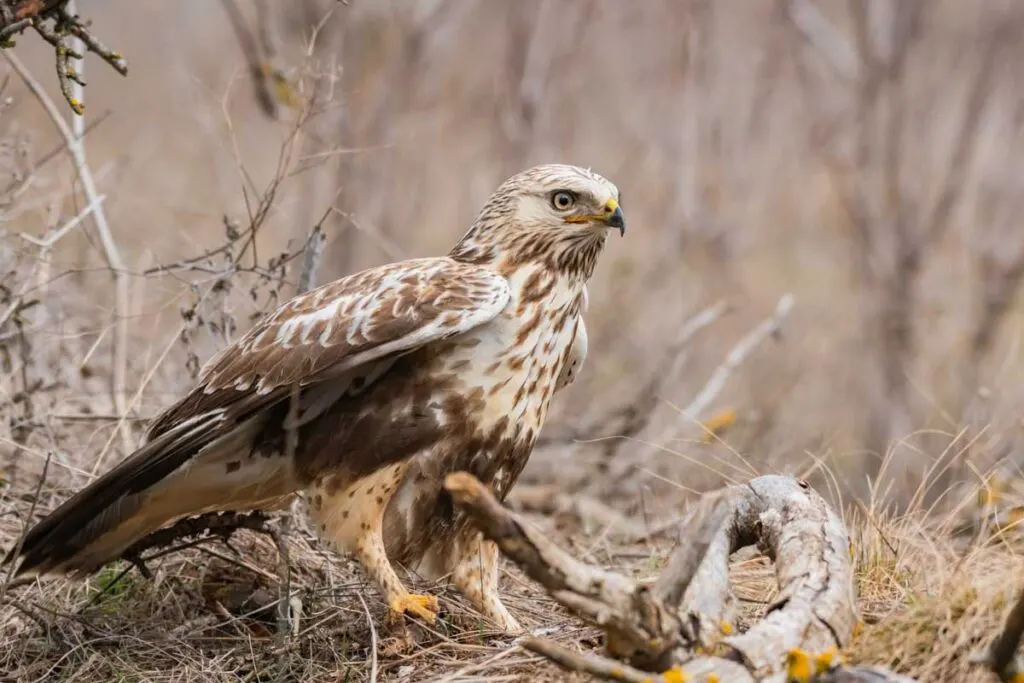
Rough-legged hawks might be due for a shave, as they are named for their feathered legs.
Besides the ferruginous hawk and golden eagle, the rough-legged hawk is the only American raptor with such a grooming characteristic.
The Buteo lagopus weighs around 2.16 pounds, which they use over summer in the arctic tundra catching lemmings.
These open-country types of hawks are best observed in southern Canada and the United States over winter.
The hawk can also be seen across the world in the northern hemisphere.
They enjoy different kinds of small mammals, with nonbreeding adults eating up to 5 small mammals daily. That amount of food amounts to about a tenth of their body weight!
11. Gray Hawk
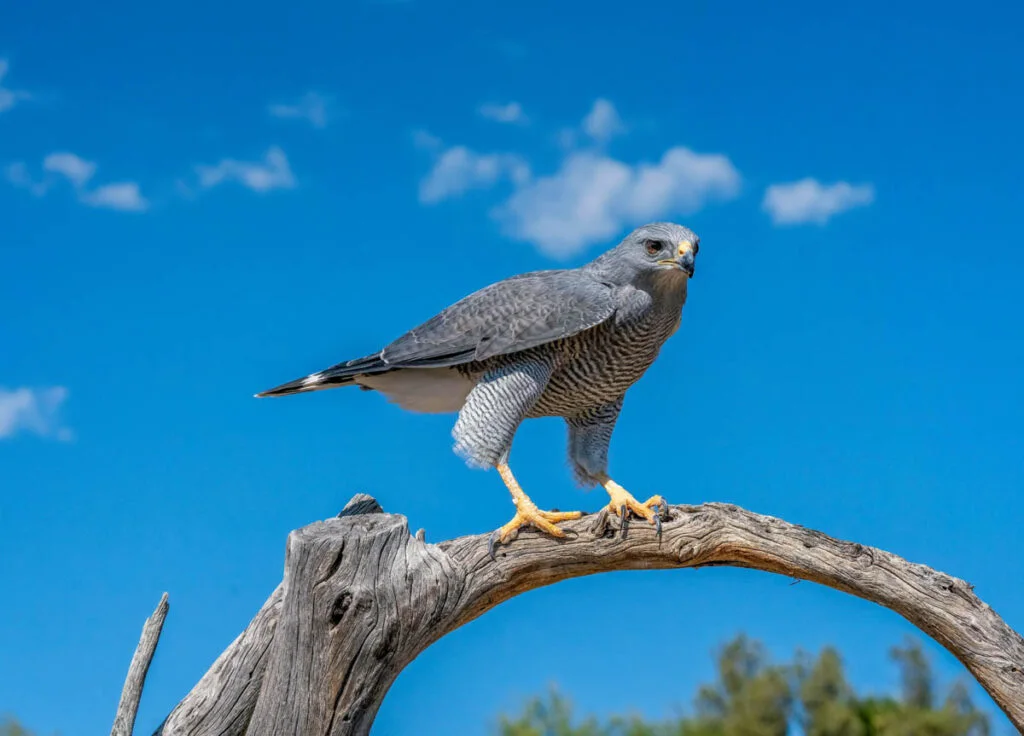
The Buteo plagiatus had its name changed from Mexican goshawk to gray hawk. Despite what you may deduce from its earlier name, the gray hawk is now known better to resemble the buteos genus (group) hawks.
These 0.838-1.455-pound hawks breed from south of Texas, edge of the Mexican east coast, south, and west coast.
You should be able to find these tropical hawks along Costa Rica and most areas of South America.
Their diet is almost exclusively made of spiny and whiptail lizards. Gray hawks also partake in a selection of vertebrates, although they can feed on many different types of species.
Did you know? Hawks have four types of color receptors in their eyes, so they can also see ultraviolet light.
12. Short-Tailed Hawk
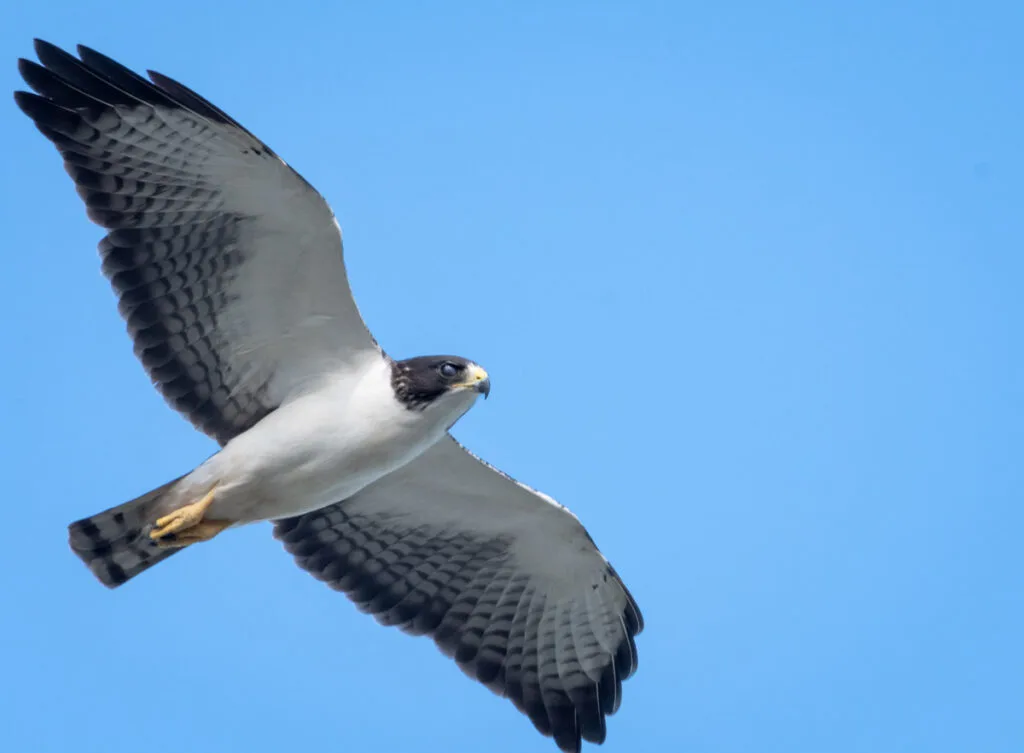
Female and male short-tailed hawks have identical solidly brown or black plumage with inner side stripes of white on the wings and tail and black bills.
The sole difference is that the females are larger in size. Females are typically 1.135 pounds, while males carry around 0.864 pounds of mass.
There are Buteo brachyurus that spot lighter and rarer plumage.
If your trusty binoculars spot a short-tailed hawk with dark-brown plumage, a white chest, and a yellow-greenish bill, then you should drop them on the spot and run yourself some Lotto numbers.
Like the short-tailed hawk skipped making a home in the US, except in Florida, forget the Lotto for your yearly colonoscopy if gambling has proven itself clingy and needy around you.
Found primarily in Central and South America, these birds have proven to be tropical species of hawks.
Instead of coconut, you’ll often see birds clenched in this hunter’s talons as it stalks the edges of mature Cyprus domes, coastal mangrove forests, pinelands, and hardwood hammocks.
13. Zone-Tailed Hawk
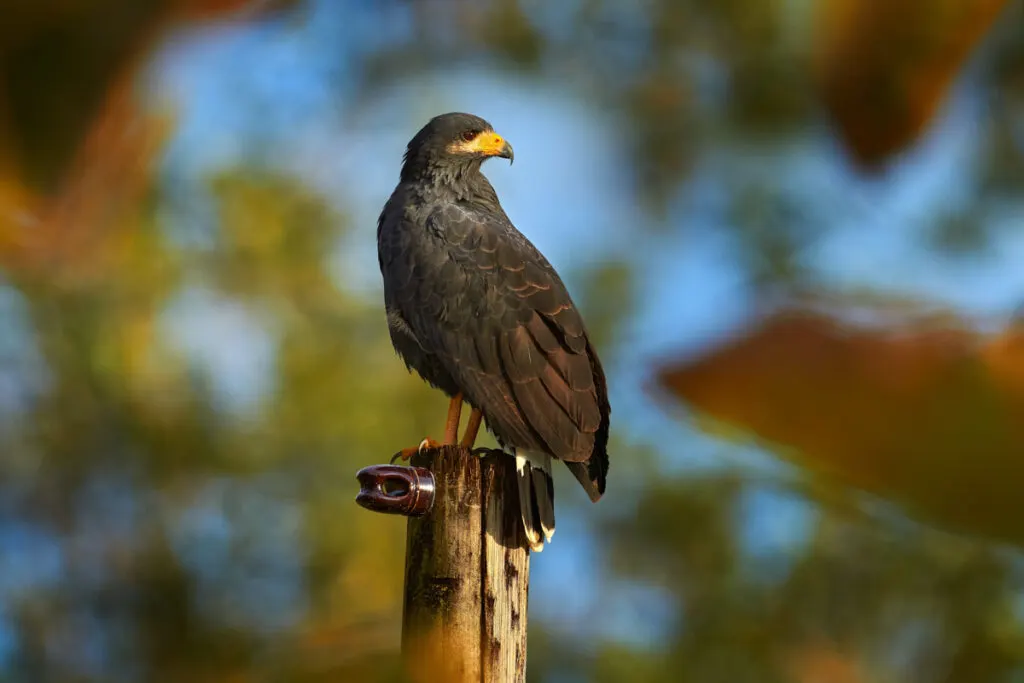
Buteo albonotatus types of hawks are now uncommon species primarily residing in central and north South America, excluding Amazonia.
You can find the 1.35-2.07 pound zone-tailed hawk in the south to southern Brazil, Paraguay, Bolivia, and sometimes in Peru.
You may mistake the zone-tailed hawk for a turkey vulture when you see it in its river woodlands, canyon, and desert mountains habitat.
It mainly hunts in open country by circling from high above while slowly descending and flanking a powerful attack on its mammal, bird, and lizard prey.
Zone-tailed hawks have no fear in defending their nesting territory and will turn aggressive at bigger foes, be they golden eagles or sticky-fingered humans.
Read next: Animals That Start With Z
14. White Hawk
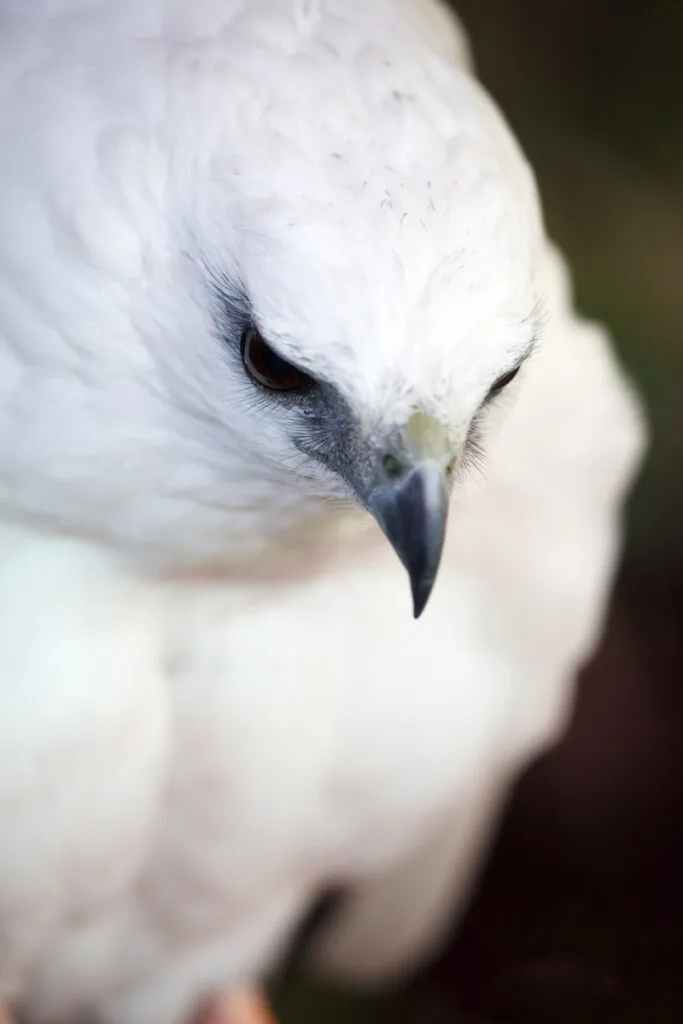
White hawk has four recognized sub-species; while it may pale to the thirteen of the red-tailed hawk, it’s still an impressive number for this 1.33-to-2-pound Pseudastur albicollis.
A neotropical species solely found in the Americas, the white hawk makes a home in lowlands with an elevation of smaller than 5,000 feet.
They roam starting in southern Mexico into most of Central America, some parts of Bolivia, and the only parts in Brazil the bird recommends at dinner parties.
Treacherous, the white hawk’s plumage doesn’t wholly abide by its name, as you can get it in other colors besides it donning the ‘white’ from its name.
The white hawk is an ally of herpetophobes, those with an active, self-preservatory fear of reptiles, as it primarily hunts reptiles, those carefree snakes, and sunbathing lizards.
15. Common Black Hawk
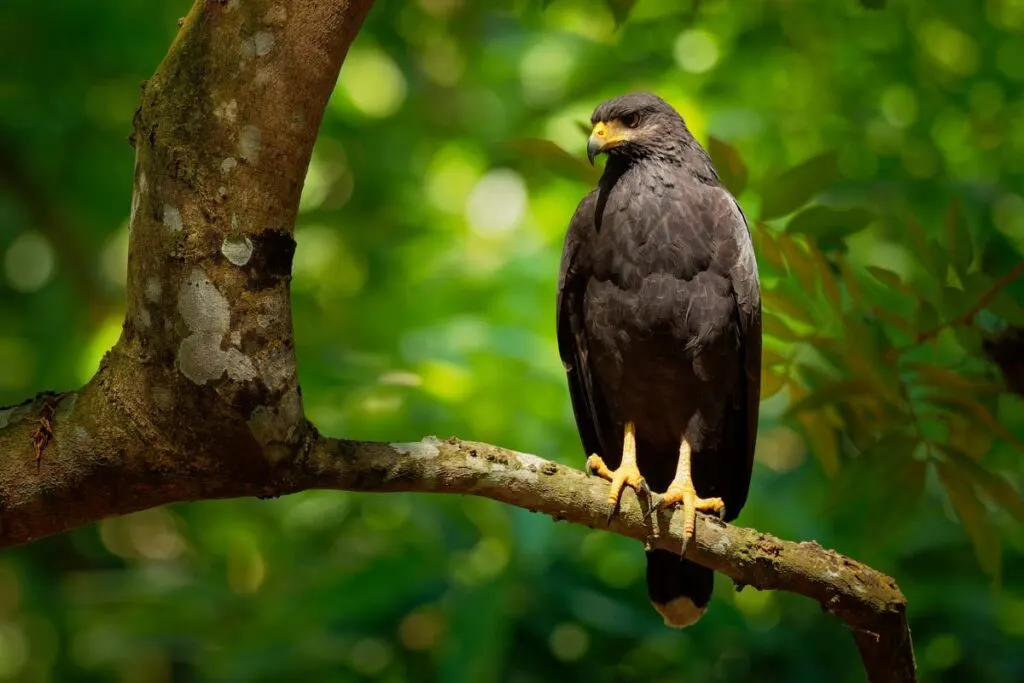
Buteogallus anthracinus are beautiful birds of prey in the same family as the free and high-powered eagles.
This roughly 2.05-pound black-colored with a white band on the tail and broad-winged hawk prowls the sky, mainly surveying from a low-hanging perch.
As the common black hawk mostly eats crabs, it sometimes forages for them by going back and forth between rocks on the water’s edge, plodding through shallow bodies of water with its yellowish legs, and stirring up its prey and nerves.
As well as wading through these surface-level water sources, this hawk also uses the fluttering of its 50-inch wingspan to startle fish for its sushi meal.
Common black hawks breed in the warmer regions of the Americas.
These types of hawks are primarily coastal birds living in mangrove swamps, river mouths, and neighboring dry and open woodland.
16. White-Tailed Hawk
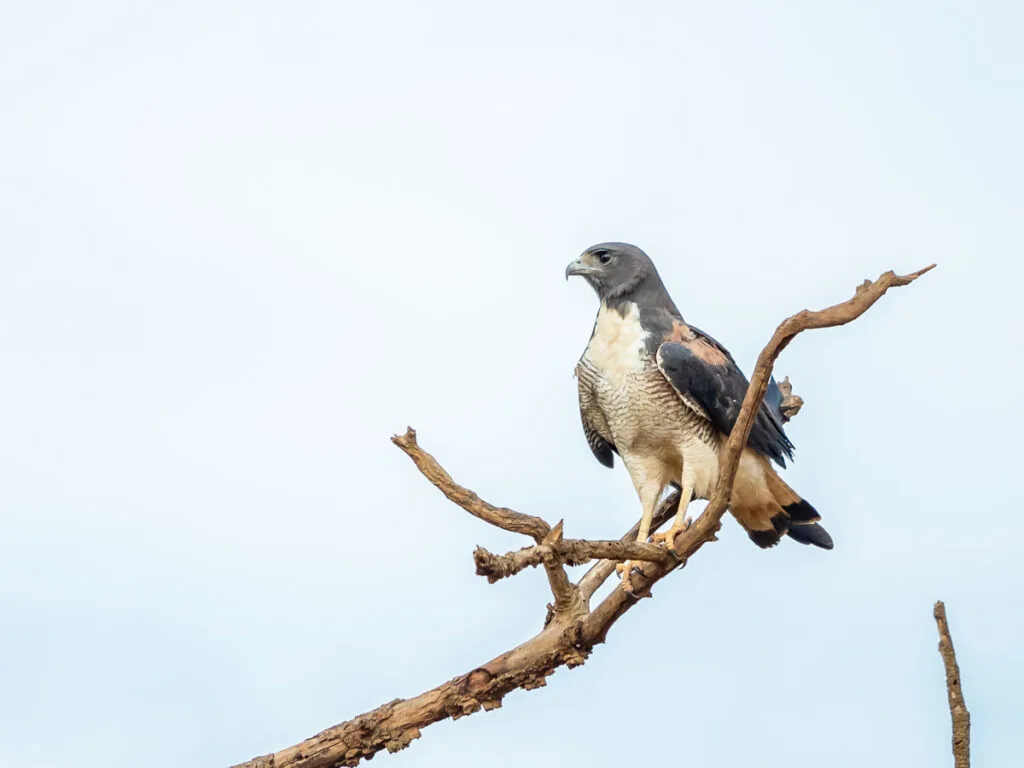
Seemingly proud of its large and stocky build, the 1.94-2.73-pound white-tailed hawk lets out a treble ke-ke-ke that you’d liken to a bleating goat.
This noticeably long-winged Geranoaetus albicaudatus is a tropical and subtropical bird of the Americas with a white tail and a black band on the very end.
These birds can be watched from many Caribbean islands and the coast of Texas and Rio Grande Valley to the central parts of Argentina.
In the Dutch West Indies, the hawk fills its diet with 12-inch lizards, while it prefers rabbits in southern Texas.
17. Rufous Crab Hawk
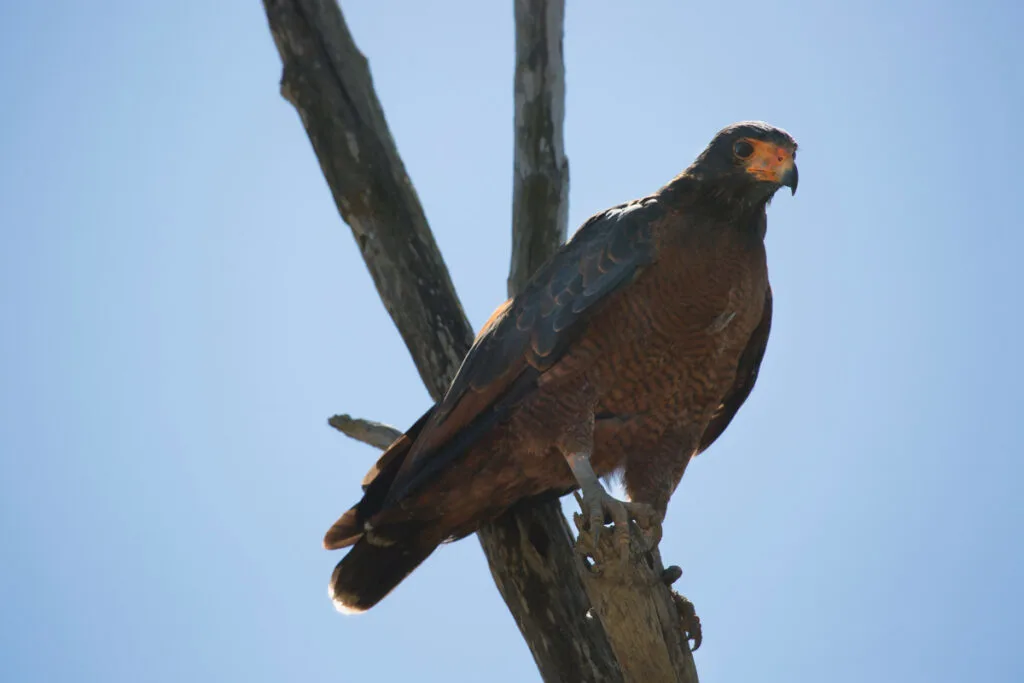
Nope, it’s not a crab with wings and talons. The Buteogallus aequinoctialis gets its name from its dark, reddish-brown (rufous) plumage and from having a diet that might be exclusively supported through crabs.
The bird’s South and North American coastal distribution enables the Rufous crab hawk’s picky-eater habit.
Female rufous crab hawks weigh 1.6-2.08 pounds, while males only carry 1.12-1.47 pounds.
As if it got away with not eating its veggies, this hawk makes a shrill “ke-kee-kee-kee-kew-kew” laugh all the way to its favorite stump to eat another helping of crab.
18. African Harrier Hawk
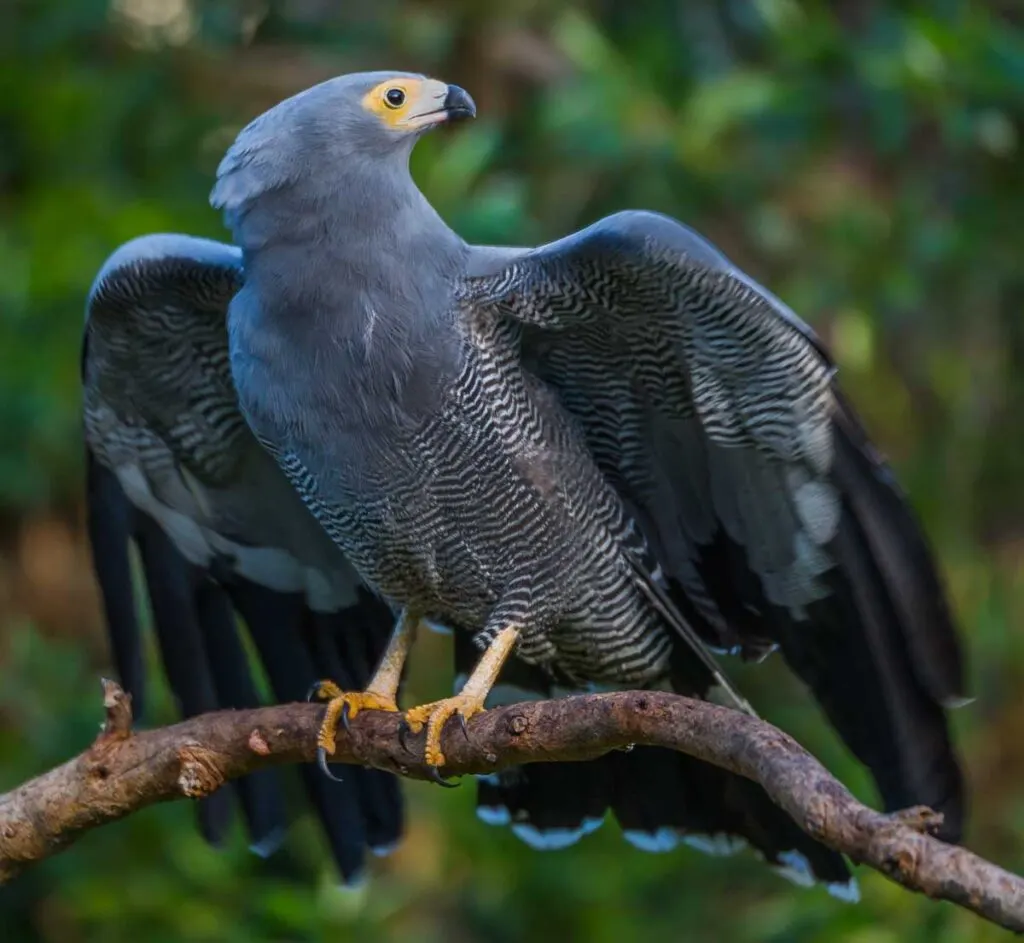
African harrier hawks are the parkour practitioners of the raptor family.
When hunting, these birds hop about the tall tree canopy or cliff faces, seemingly showboating by flapping wings to adjust their balance as they grip vertical surfaces, looking for their prey’s hiding holes in trees and rock crevices.
Flipping the bird was probably invented by other birds just for this Polyboroides typus.
This hawk has a dismal approval rating from other birds as it uses all its parkour skills to raid these hidden nests for eggs and fledglings.
The African harrier hawk can weigh up to 1.39 pounds. A weight sustained through hunting eggs in weaver colonies, plover and duck eggs in sandbanks, and other eye-raisers in northeastern South Africa.
19. Pale Chanting Goshawk
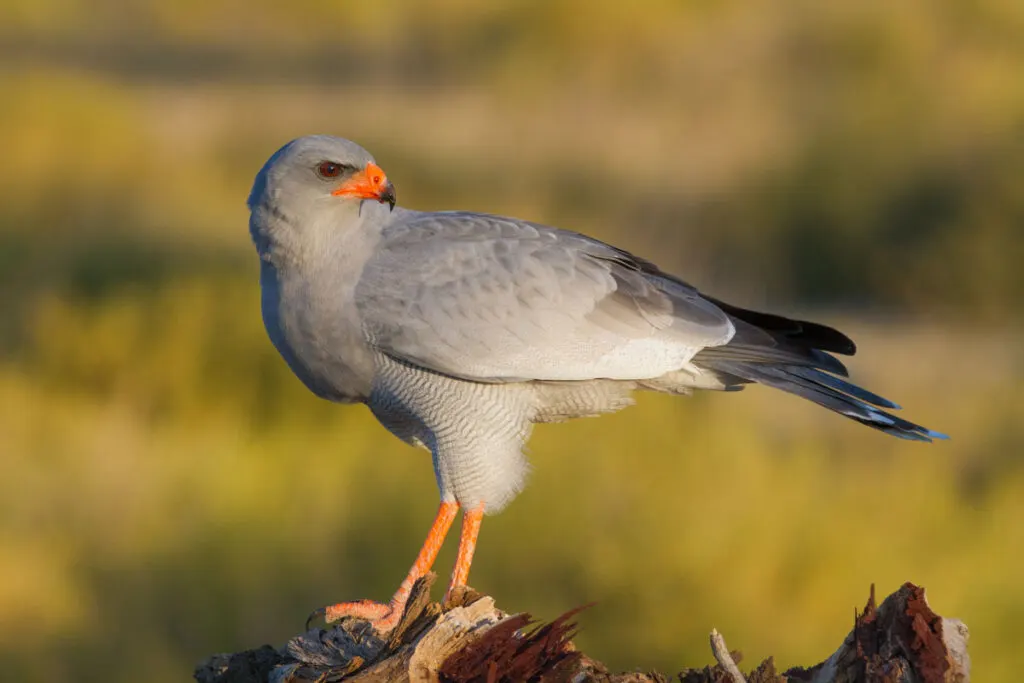
Males of pale chanting goshawks will sing melodious calls for hours at the start of the bird’s mating season. Successful pairs can be seen rising in circles into the sky.
These birds prefer desert plains or thorny, semi-desert bushvelds because of these habitats’ spaciousness and their open-plan layout.
You can steal a glimpse of the Melierax canorus types of hawks in eastern and southern Africa.
To keep a healthy belly and a weight of around 0.9-1.65 pounds for males and 1.65-2.2 pounds for females, this raptor enjoys the small mammals that live in the long grass of its environment, lizards and insects.
20. Black-Faced Hawk
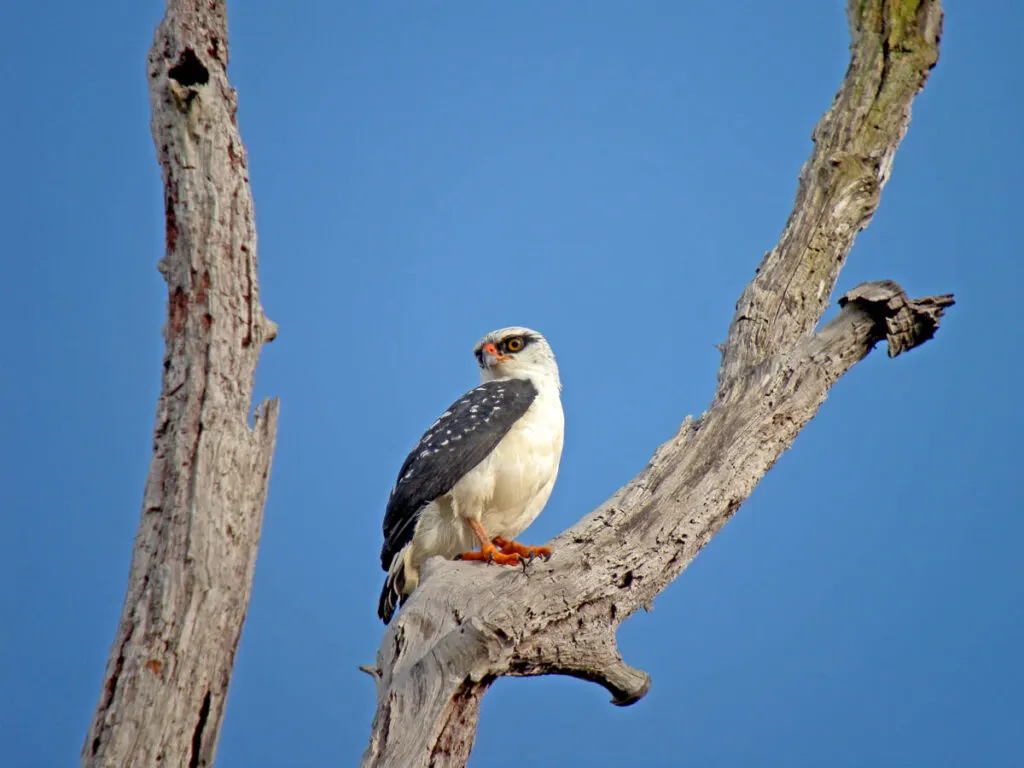
Leucopternis melanops has a low population density that appears to be mainly concentrated north of the Amazon River, with a few possible reports south of this region.
Black-faced hawks have a white chest, black wings, and a white head with streaks of black, which resembles a mask on the bird’s face.
This raptor likes the tall lowlands of the Amazon forest and is okay with making habits at the forest’s edge, along mangroves and rivers.
At 0.655-0.699 pounds for males and 0.725-0.838 pounds for females, it’s thought that the black-faced hawk primarily eats snakes and reptiles.
21. Crested Goshawk
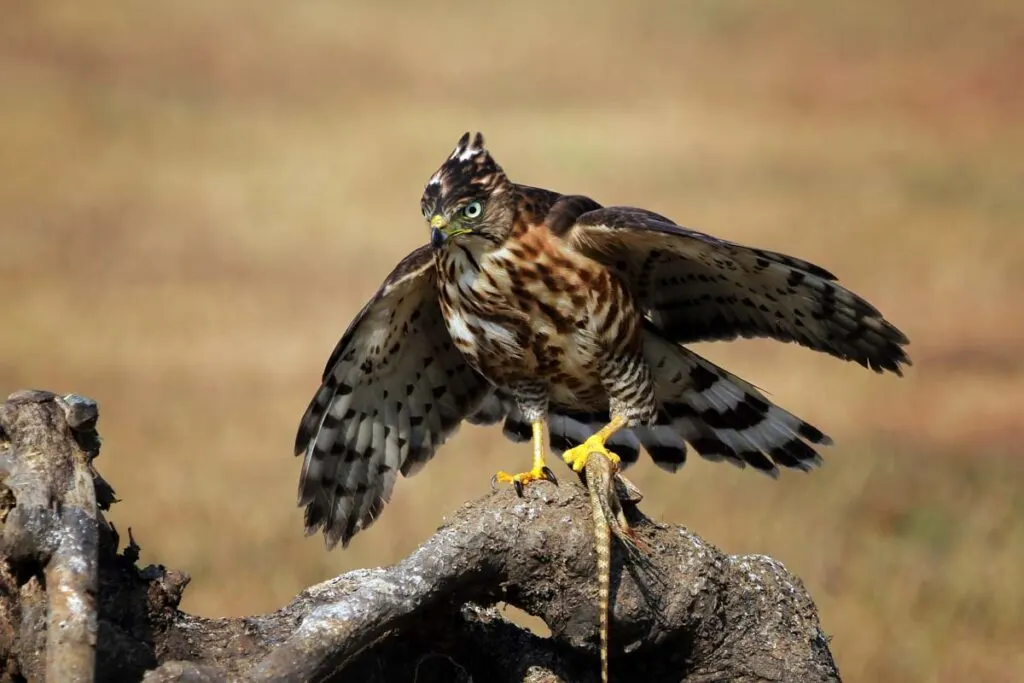
Crested goshawks hunt mainly for small mammals, birds, and reptiles in the tree canopy, forest interiors, and plantations.
Accipiter trivirgatus types of hawks are lone wolves throughout the year except during the breeding seasons.
It’s difficult to pinpoint where these birds spend most of their time as they are both rare animals from lower numbers and dispersed.
Their native regions are Southeast Asia, southern China, and India. They’ve been spotted nesting in different parks and natural reserves like Pulau Ubin, Bukit Timah Nature Reserve, and the Botanic Gardens in Singapore.
These birds can weigh just under or over a pound and have been photographed eating Javan mynas and fruit bats.
More Types of Hawks
Ridgway’s hawk
Hawaiian hawk
Roadside hawk
Chestnut-shouldered goshawk
Northern Harrier
Henst’s Goshawk
Crane hawk
Great black hawk
Black-Mantled Goshawk
Brown Goshawk
Fiji Goshawk
Did you enjoy learning more about the different types of hawks? Then share this article with your friends!!
21 Incredible Types of Hawks to Spot in the Wild
1. Red-Tailed Hawk
2. Sharp-Shinned Hawk
3. Cooper’s Hawk
4. Northern Goshawk
5. Red-Shouldered Hawk
6. Broad-Winged Hawk
7. Ferruginous Hawk
8. Harris’s Hawk
9. Swainson’s Hawk
10. Rough-Legged Hawk
11. Gray Hawk
12. Short-Tailed Hawk
13. Zone-Tailed Hawk
14. White Hawk
15. Common Black Hawk
16. White-Tailed Hawk
17. Rufous Crab Hawk
18. African Harrier Hawk
19. Pale Chanting Goshawk
20. Black-Faced Hawk
21. Crested Goshawk
